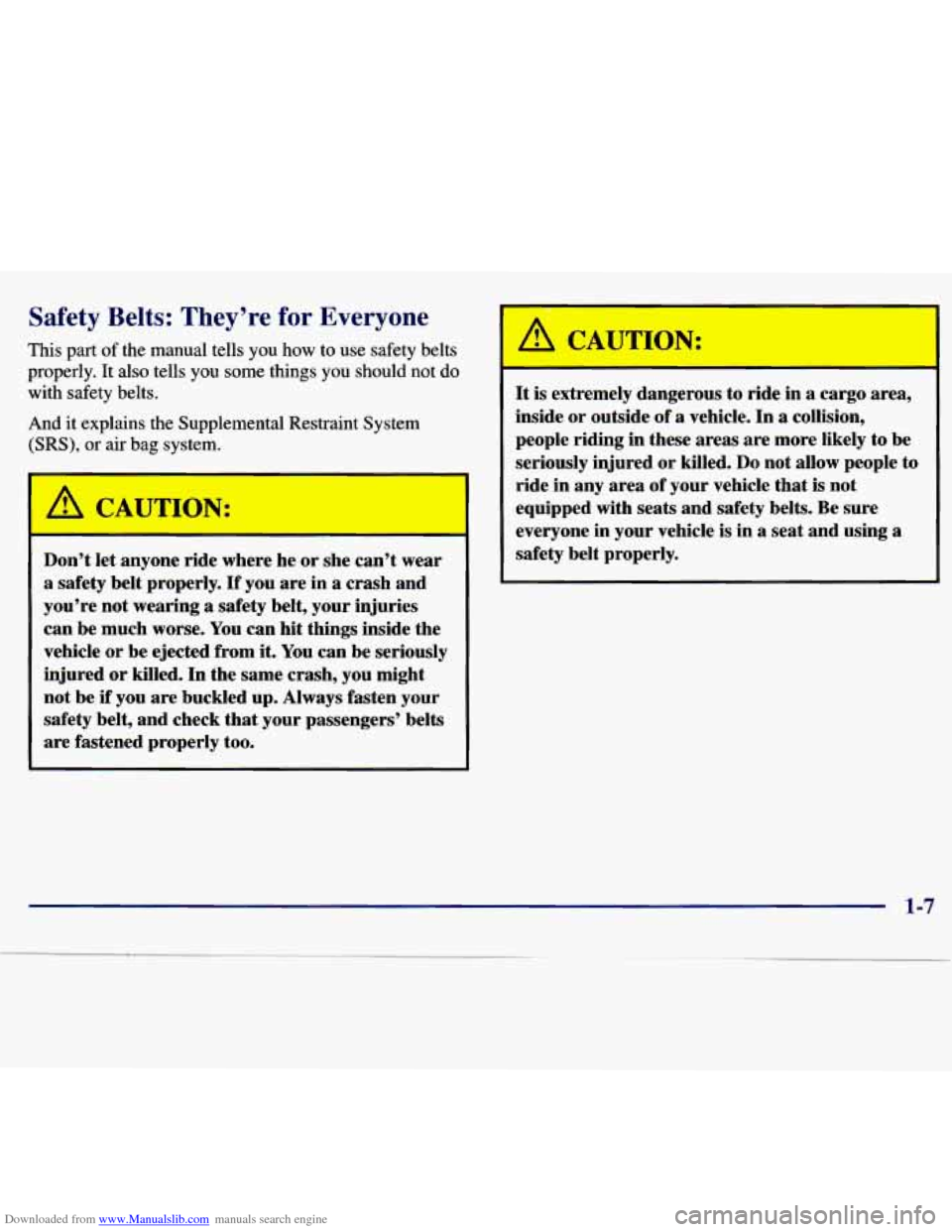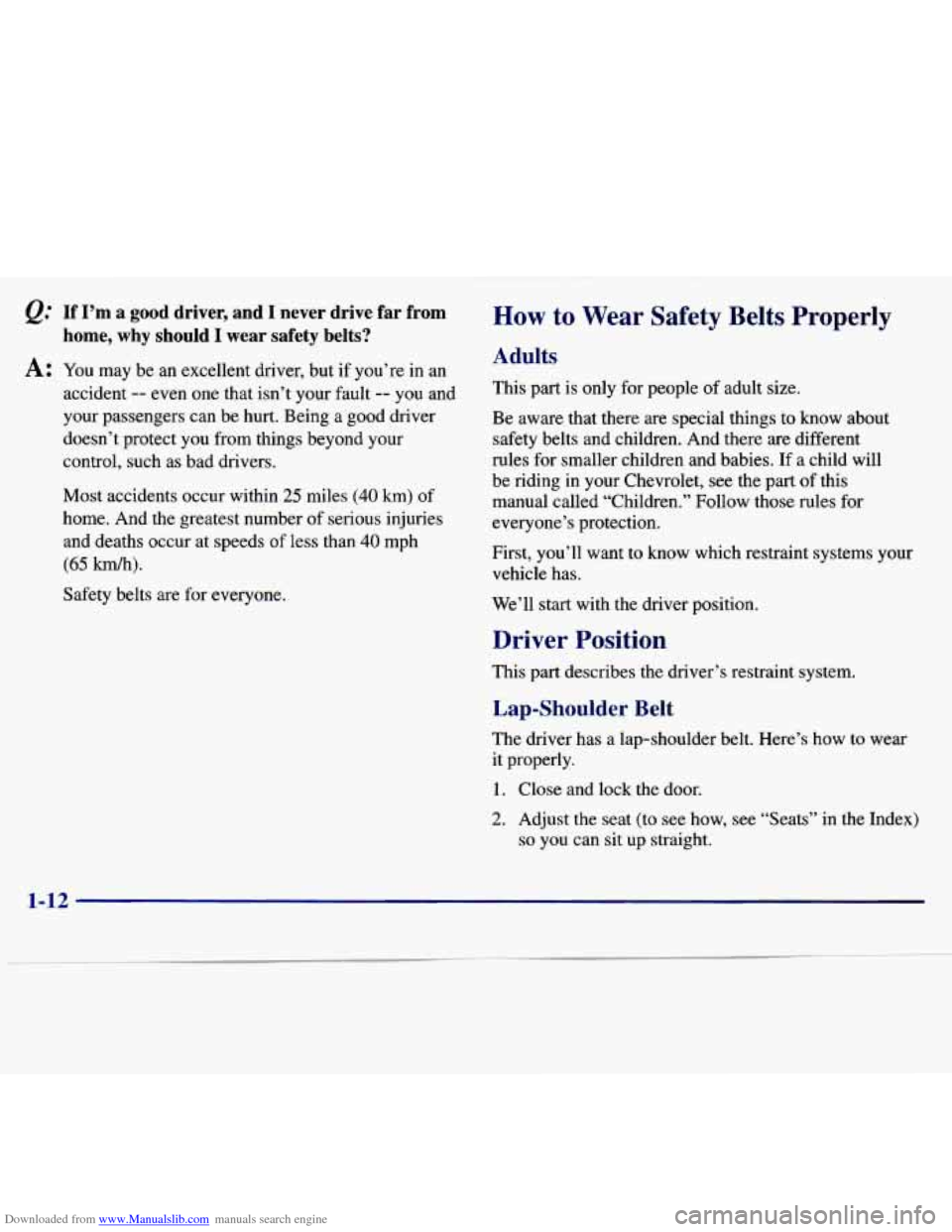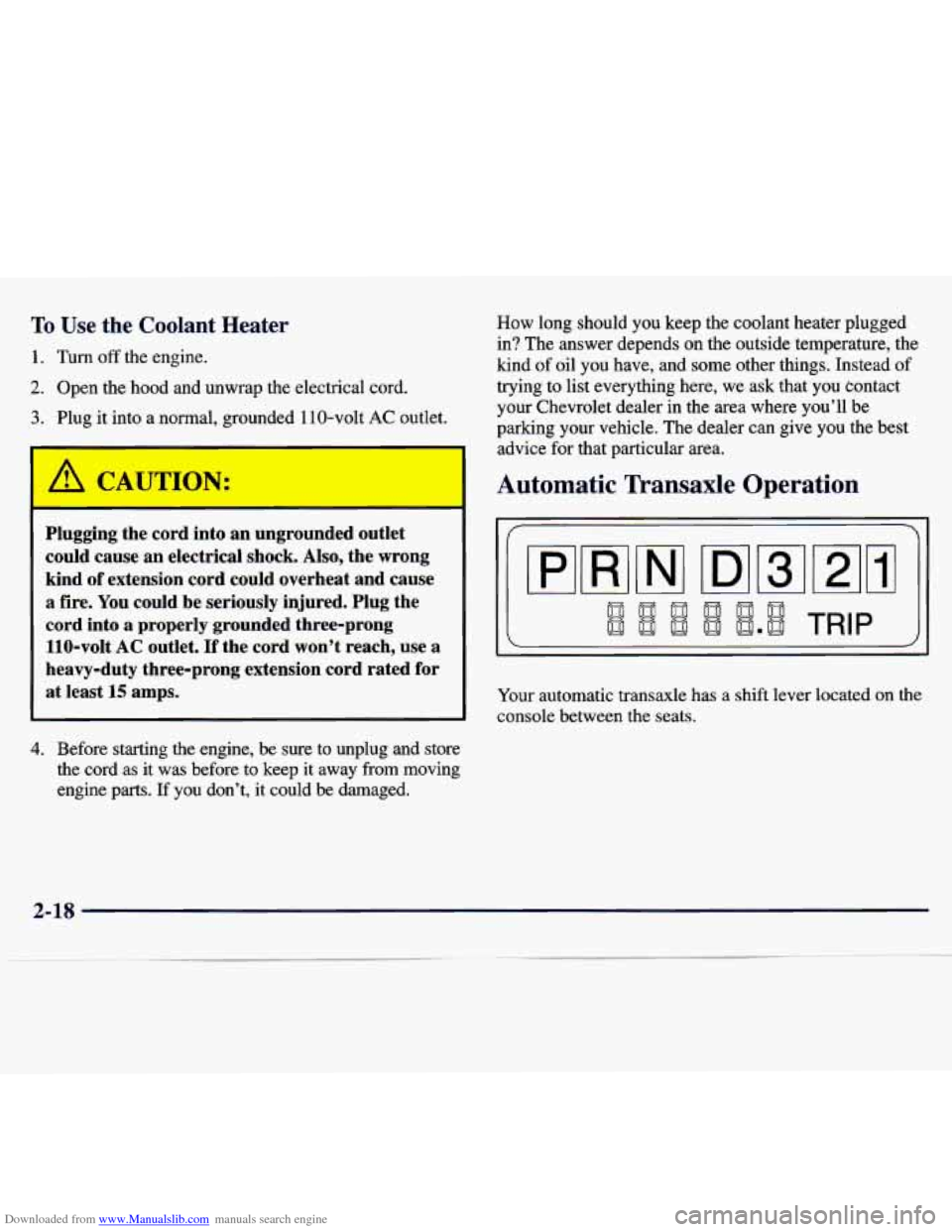Page 2 of 354

Downloaded from www.Manualslib.com manuals search engine .* a The 1997 Chevrolet Malibu Owner’s Manual
1-1
2-1
3-1
4- 1
5- 1
6-1
7-1
8-1
9- 1
Seats and Restraint Systems
This section tells you how to use your seats and safety belts\
properly. It also explains the “SRS” system.
Features and Controls
This section explains how to start and operate your Chevrolet.
Comfort Controls and Audio Systems
This section tells you how to adjust the ventilation and comfo\
rt controls and how to operate your audio system.
Your Driving and the Road
Here you’ll find helpful information and tips about the road\
and how to drive under different conditions.
Problems on the Road
This section tells what to do if you have a problem while driving, such as a flat tire or overheated engine, etc.
Service and Appearance Care
Here the manual tells you how to keep your Chevrolet running properly and looking good.
Maintenance Schedule
This section tells you when to perform vehicle maintenance and \
what fluids and lubricants to use.
Customer Assistance Information
This section tells you how to contact Chevrolet for assistance \
and how to get service and owner publications.
It
also gives you information on “Reporting Safety Defects” on page 8-10.
Index
Here’s an alphabetical listing of almost every subject in this manual. You can use it to quickly find
something you want to read.
i
Page 10 of 354
Downloaded from www.Manualslib.com manuals search engine Section 1 Seats and Seat Restraints
Here you’ll find information about the seats in your Chevrol\
et and how to use your safety belts properly. You can also
learn about some things you should
not do with air bags and safety belts.
1-2
1-2
1-3
1-4
1-5
1-8 1-11
1-12 1-15 Seats and Controls
Manual Seats
Power Seats
Reclining Front Seatbacks
Rear Seats
Why Safety Belts Work
Questions Many People Ask About
Safety Belts
How to Wear Safety Belts Properly
Shoulder Belt Height Adjuster 1-20
1-23
1-30
1-34
1-36
1-37
1-47
1-47 1-47 Safety Belt Use During Pregnancy
Questions and Answers About Air Bags Safety Belt Comfort Guides
How to Use Child Restraints
Important Information for Buckling Children in Child Restraints
Child Restraint Top Straps
How to Obtain a Safety Belt Extender
Checking Your Restraint Systems
Replacing Parts After a Crash
1-1
-----
Page 11 of 354
Downloaded from www.Manualslib.com manuals search engine Seats and Seat Controls
This section tells you about the seats -- how to
adjust
them -- and also about reclining seatbacks
and head restraints.
You can lose control of the vehicle if you try to
adjust a manual driver's seat while the vehicle is
moving. The sudden movement could startle and
confuse you, or make you push
a pedal when you
don't want to. Adjust the driver's seat only when
the vehicle is not moving. Move the lever under the front sear IO unlock it. Slide
the seat to where you want it. Then release the lever and
try to move the seat with your body, to make sure
the
seat is locked into place.
1-2
Page 15 of 354
Downloaded from www.Manualslib.com manuals search engine Rear Seats
Folding Rear Seat (If Equipped)
To open the folding rear seat, open the trunk and pull
one or both
of the tethers located on the left side of the
trunk. The leaf-hand tether will open the larger side
of
the seatback. The right-hand tether will open the smaller
side of the seatback. Once a tether is pulled, the seatback
can be pushed open through the trunk,
or pulled open
from inside the vehicle.
To close the folding rear seat from inside the car, push
the seatback
up until you hear a click. Then pull on the
seatback
to make sure it is secure.
Page 16 of 354

Downloaded from www.Manualslib.com manuals search engine Safety Belts: They’re for Everyone
This part of the manual tells you how to use safety belts
properly. It also tells you some things you should not
do
with safety belts.
And it explains the Supplemental Restraint System
(S ;), or air bag system.
Don’t let anyone ride where he or she can’t wear
a safety belt properly. If you are in a crash and
you’re not wearing a safety belt, your injuries
can be much worse. You can hit things inside the
vehicle or be ejected from it. You can be seriously
injured or killed. In the same crash, you might
not be
if you are buckled up. Always fasten your
safety belt, and check that your passengers’ belts
are fastened properly too.
It is extremely dangerous to ride in a cargo area,
inside or outside of a vehicle. In a collision,
people riding in these areas are more likely to be
seriously injured or killed.
Do not allow people to
ride in any area of your vehicle that is not
equipped with seats and safety belts. Be sure
everyone in your vehicle
is in a seat and using a
safety belt properly.
1-7
Page 21 of 354

Downloaded from www.Manualslib.com manuals search engine @ If I’m a good driver, and I never drive far from
A: You may be an excellent driver, but if you’re in an
home, why should I wear safety belts?
accident -- even one that isn’t your fault -- you and
your passengers can be hurt. Being a good driver
doesn’t protect you from things beyond your
control, such as bad drivers.
Most accidents occur within
25 miles (40 km) of
home. And the greatest number
of serious injuries
and deaths occur at speeds of less than
40 mph
(65 km/h).
Safety belts are for everyone.
H,,, to Wear Safety Belts Properly
Adults
This part is only for people of adult size.
Be aware that there are special things to know about safety belts and children. And there are different
rules for smaller children and babies. If
a child will
be riding in your Chevrolet, see the part of this
manual called “Children.” Follow those rules for
everyone’s protection.
First, you’ll want to know which restraint systems your vehicle has.
We’ll start with the driver position.
Driver Position
This part describes the driver’s restraint system.
Lap-Shoulder Belt
The driver has a lap-shoulder belt. Here’s how to wear
it properly.
1. Close and lock the door.
2. Adjust the seat (to see how, see “Seats” in the Index)
so you can sit up straight.
1-12
Page 51 of 354

Downloaded from www.Manualslib.com manuals search engine Securing a Child Restraint in the Right
Front Seat Position
Pour vehicle has a right front passenger air bag. Never
put a rear-facing child restraint in this seat. Here’s why:
PL CAUTION:
A child in a rear-facing child restraint can be
seriously injured if the right front passenger’s air
bag inflates. This is because the back of a rearfacing child restraint would be very close to
the inflating air bag. Always secure
a rearfacing
child restraint in the rear seat.
You’ll be using the lap-shoulder belt. See the earlier part
about the top strap if the child restraint has one.
1. Because your vehicle has a right front passenger air
bag, always move the seat as far back as it will go
before securing a forward-facing child restraint. (See
“Seats” in the Index.)
2. Put the restraint on the seat. Follow the instructions
for the child restraint.
3. Secure the child in the child restraint as the
instructions say.
4. Pick up the latch plate, and run the lap and shoulder
portions of the vehicle’s safety belt through or
around the restraint. The child restraint instructions
will show you how.
1-42
Page 75 of 354

Downloaded from www.Manualslib.com manuals search engine To Use the Coolant Heater
1. Turn off the engine.
2. Open the hood and unwrap the electrical cord.
3. Plug it into a normal, grounded 1 10-volt AC outlet.
A CAUL :ON:
Plugging the cord into an ungrounded outlet
could cause an electrical shock. Also, the
wrong
kind of extension cord could overheat and cause
a fire. You could be seriously injured. Plug the
cord into a properly grounded three-prong 110-volt
AC outlet. If the cord won’t reach, use a
heavy-duty three-prong extension cord rated for
at least 15 amps.
4. Before starting the engine, be sure to unplug and store
the cord as it was before to keep it away from moving
engine parts.
If you don’t, it could be damaged. How long should you keep the coolant heater plugged
in?
The answer depends on the outside temperature, the
kind of oil you have, and some other things. Instead of
trying to list everything here, we ask that you contact
your Chevrolet dealer in the area where you’ll be
parking your vehicle. The dealer can give you the best
advice for that particular area.
Automatic Transaxle Operation
Your automatic transaxle has a shift lever located on the
console between the seats.
2-18